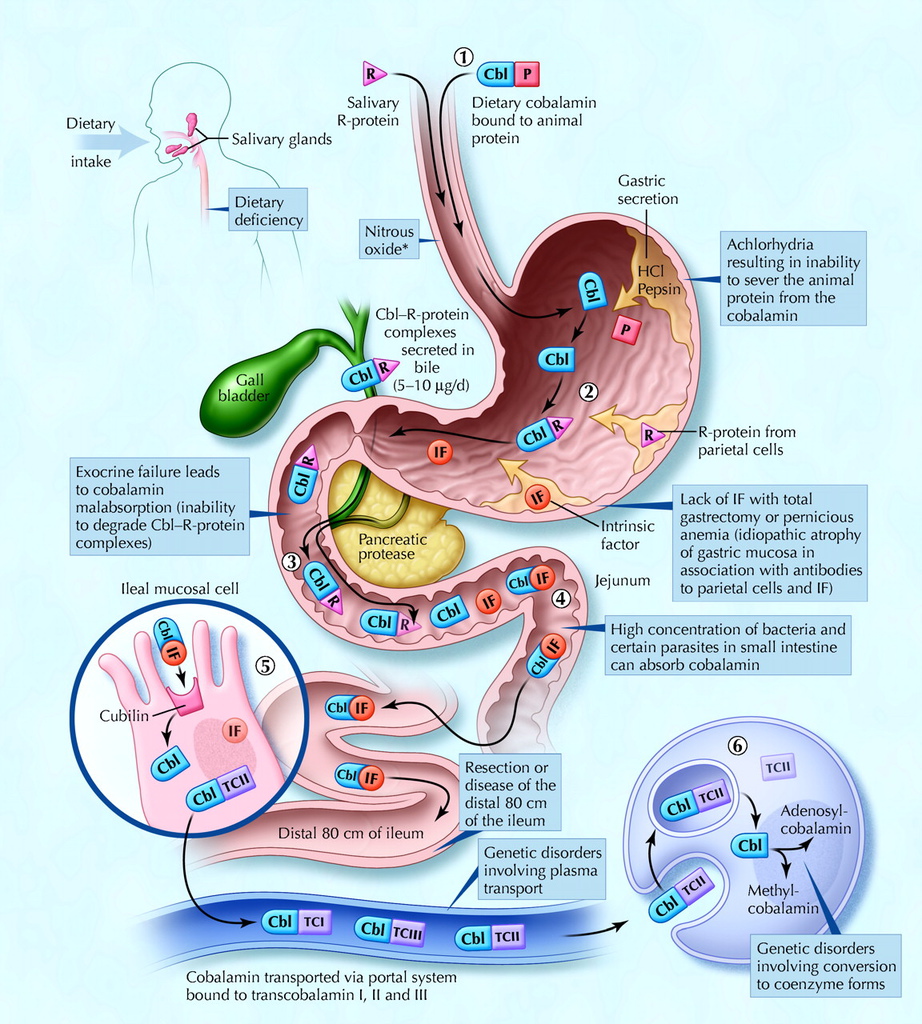
(from:CMAJ)
DIAGNOSIS
Who to Test 誰要檢測
- Presentation: Unexplained neurologic symptoms, such as paresthesias, numbness, poor motor coordination, memory lapses or cognitive and personality changes. Anemia with features as described below.
- Laboratory findings: macrocytic anemia or macrocytosis with oval macrocytes or hypersegmented neutrophils or pancytopenia.
Consider Testing 考慮檢測的狀況
- Demographics: elderly, i.e., >75 years
- Medical history: inflammatory bowel disease (of small intestine)
- Surgical history: gastric or small intestine resection
- Dietary history: prolonged vegan diet, i.e., no meat, poultry or dairy products
- Medication history: long-term use of histamine (H2) receptor antagonists or proton pump inhibitors (at least 12 months), or metformin (at least 4 months)
Routine screening for cobalamin deficiency is not indicated.
How to Test 怎麼檢測
Perform a complete blood count (CBC), blood film and serum cobalamin in all patients suspected of cobalamin deficiency. Interpret serum cobalamin levels in light of clinical symptoms, because the test has the following limitations:
- It measures total, not metabolically active cobalamin.
- The levels of cobalamin do not correlate well with clinical symptoms. Elderly patients may have normal cobalamin levels with clinically significant cobalamin deficiency, while women taking oral contraceptives may have decreased blood cobalamin levels due to a decrease in transcobalamin, a carrier protein, but no clinical symptoms of deficiency.
- There is a large 'grey zone' between the normal and abnormal levels.
- The reference intervals may vary between laboratories. The conventional cut-off for serum cobalamin deficiency varies from 150 to 220 pmol/L. Using a more common cut-off of 220 pmol/L, the following interpretation is recommended:
|
Serum Cobalamin (pmol/L) |
Probability of Symptomatic Deficiency |
|
<75 |
High |
|
75-150 |
Moderate |
|
150-220 |
Low |
|
>220 |
Rare |
MANAGEMENT 處置
Treatment 治療方法
Early treatment of cobalamin deficiency is particularly important because neurologic symptoms may be irreversible.
- Oral crystalline cyanocobalamin (commonly available form) is the treatment of choice. Dosing for pernicious anemia or food-bound cobalamin malabsorption is 1000 mcg/day. In most other cases a dose of 250 mcg/day may be used.
- Oral administration of cobalamin is as effective as parenteral (see Figure 1 in the original guideline document).
- Advantages of oral supplementation are comfort, ease of administration, and cost.
- Prophylactic cobalamin supplementation is recommended for strict vegans and patients with food bound cobalamin malabsorption, and for pernicious anemia.
- Usefulness of prophylactic administration of cobalamin in elderly is unknown.
Parenteral administration should be reserved for those with significant neurological symptoms. It includes 1-5 intramuscular or subcutaneous injections of 1000 mcg crystalline cyanocobalamin daily, followed by oral doses of 1000-2000 mcg/day. Retest serum cobalamin levels after 4-6 months to ensure they are in the normal range.
Supplements 補充
- Toxicity is minimal (especially with doses usually used in supplementation).
- Oral supplements are available over the counter in various doses and dosage forms; prices will vary.
ONGOING CARE
Duration of Therapy
Patients with pernicious anemia require lifelong therapy, while patients with food-malabsorption require treatment until underlying condition or diet is corrected (see Appendix A in original guideline document for dietary sources of cobalamin).
Monitoring
Annual testing of blood cobalamin levels is recommended in patients with non-nutritional cobalamin deficiency
[Evidence Supporting the Recommendations]
[Link to free full-text BCMSC guideline PDF | NGC version online]





 留言列表
留言列表
 線上藥物查詢
線上藥物查詢 